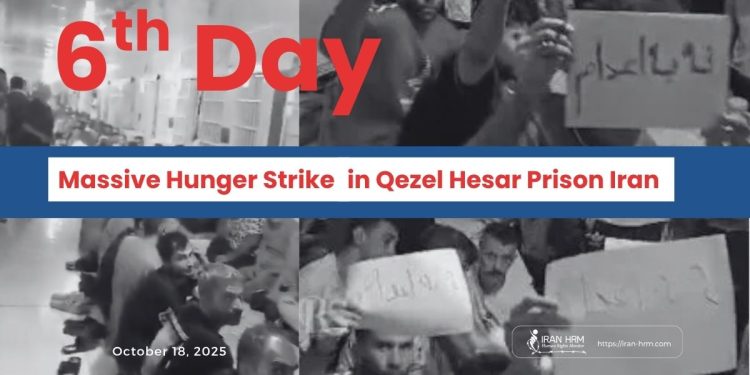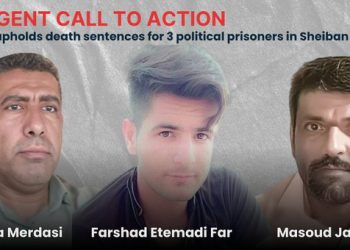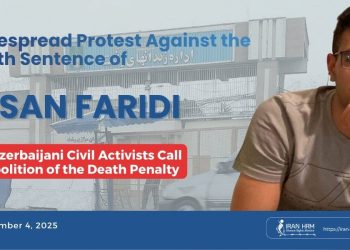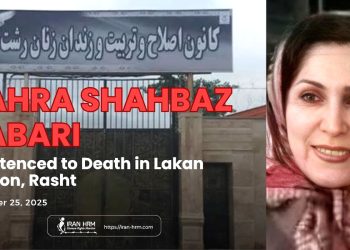On October 18, 2025 (Mehr 26, 1404), Qezel Hesar Prison near Karaj witnessed one of the largest collective protests in Iran’s recent history. Over 1,500 prisoners on death row, mostly convicted of drug-related or homicide charges, began a mass hunger strike on October 12. The strike was triggered when 16 inmates were transferred to solitary confinement ahead of execution and continued for at least seven days.
According to inside sources, prison guards tried to remove those who had sewn their lips shut, but others resisted and prevented them. Videos leaked from Unit 2 show dozens of prisoners with stitched lips holding hand-written signs reading “No to Execution” and a banner that says: “Do not come to bury us—come to help us.”
Authorities cut off drinking water and phone lines using signal jammers. Reports described dozens collapsing from exhaustion and low blood pressure.
What distinguishes this hunger strike is not only its unprecedented scale but also its social composition. Most participants are non-political inmates from marginalized backgrounds. By joining the No to Execution campaign and chanting “Life is our right,” they bridged the gap between political and non-political prisoners. Unit 2 has thus transformed from a place of silence into a symbol of collective resistance against death.
“For bread, for freedom, for our children, for our right to live—we have sewn our lips to stop death.”
Motives, Symbolism, and Impact on the Regime
This hunger strike is more than a desperate reaction; it is a collective declaration against the logic of death in Iran’s judicial system. The transfer of inmates to solitary confinement—effectively a death announcement—sparked a movement that evolved from fear into purpose. Through silence and sewn lips, the prisoners chose to challenge death at its doorstep.
The message “Do not come to bury us—come to help us” encapsulates the spirit of the strike: hope in the midst of despair. The participation of more than 1,500 impoverished inmates—many victims of economic inequality and state neglect—demonstrated that the death penalty has lost its deterrent function and has become a catalyst for resistance.
Socially, the Qezel Hesar strike erased the line between political and non-political prisoners, uniting them under one demand: the right to life. Politically, it marks the collapse of judicial deterrence. The regime has long used executions as a tool of social control, but the growing defiance inside Qezel Hesar shows that executions now provoke solidarity rather than fear.
This strike continues the “Tuesdays No to Execution” campaign that began in Qezel Hesar and spread to more than fifty prisons nationwide. The current protest represents its peak — a structured act of resistance within prison walls. Qezel Hesar is no longer a site of execution; it has become the stage for the regime’s moral and judicial breakdown, where silence has turned into the loudest cry for justice.
From Sewn Lips to Global Echoes
Voices from Inside: ‘No to Execution’ in the Heart of Darkness
“These men love life and dignity so fiercely that they are willing to die for it—so that if not for themselves, at least others after them may have the right to live.”
“Defending the right to life leads to demands for freedom and justice—and that is why this regime of death fears it.”
“The month of Mehr (September 23 → October 22) has been the bloodiest month for death row inmates, with more than 200 executions. We, the prisoners of Unit 2, tired of waiting for death, have sewn our lips shut to say: Execution is not the solution.”
International Reactions and Global Human Rights Response
United Nations (OHCHR and UN Experts)
At the United Nations, High Commissioner for Human Rights Volker Türk once again urged Iran:
“to impose a moratorium on the application of the capital punishment, as a step towards its abolition.”
In a separate September 2025 statement, UN experts warned:
“Over 1,000 people have been killed in less than nine months of 2025 … Iran appears to be conducting executions at an industrial scale that defies all accepted standards of human-rights protection.”
“International law restricts capital punishment to only the ‘most serious crimes’—interpreted as intentional murder. Drug offences do not meet this threshold.”
United States: Targeted Sanctions on Qezel Hesar Prison
The U.S. Department of State imposed direct sanctions on Qezel Hesar Prison under Section 106 of the Countering America’s Adversaries Through Sanctions Act (CAATSA), citing “gross violations of human rights.”
“I have determined that Ghezel Hesar Prison in Iran meets the criteria under Section 106 of CAATSA. This prison was the site of gross violations of human rights,” the Secretary of State announced.
“This prison was the site of gross violations of human rights, namely cruel, inhuman and degrading treatment and punishment of individuals in Iran who sought to exercise their right to freedom of expression. These heinous acts included multiple severe beatings of political prisoners engaged in a peaceful hunger strike to protest the increased wave of executions being carried out at the facility.”
European Union and Council of Europe
The European Union (EU) and the Council of Europe reaffirmed their “unequivocal opposition to the death penalty, in all cases and in all circumstances.”
The EU further urged Iran to uphold its obligations under international law, including the International Covenant on Civil and Political Rights (ICCPR), to which Iran is a party.
Human Rights Organizations and Global Voices
Amnesty International stated on October 18:
“The latest executions in Qezel Hesar, including those of Behrouz Ehsani and Mehdi Hassani, are arbitrary and horrific. The Iranian authorities are using the gallows to instill fear. We demand the immediate halt of all death sentences.”
The Global Anti-Death Penalty Network declared:
“The Qezel Hesar hunger strike marks the first large-scale alliance between political and non-political prisoners in Iran’s history. It has blurred the line between crime and justice and turned the defense of life into a universal demand.”
Over 300 international figures — including members of European parliaments, Nobel laureates, and international jurists — issued a joint warning:
“The unchecked escalation of executions in Iran signals the risk of another mass atrocity. The global community must act now, before it is too late.”
Demonstrations in Vancouver, Paris, and Malmö, along with the viral hashtag #StopExecutionsInIran, have turned Qezel Hesar into a global symbol of resistance against state violence.
Conclusion and Call for Global Action
The hunger strike of 1,500 death-row inmates in Qezel Hesar is not an isolated incident; it is a national manifesto against a state policy of death rooted in inequality and injustice. These non-political prisoners from Iran’s poorest classes have sewn their lips shut to declare that execution is neither justice nor deterrence, but a weapon of vengeance used by the regime against its own people.
Qezel Hesar has become a symbol of the regime’s crisis of legitimacy: a place where the instruments of fear have turned into tools of exposure. A government that ties its power to the noose reveals its own weakness and fear.
This crisis has now transcended Iran’s borders. The responses of the United Nations, European Union, United States and global civil society demonstrate that the Iranian death-penalty policy is no longer a domestic issue but a test of the international community’s commitment to human dignity.
Recommended Actions:
1. Impose targeted sanctions on officials and prison authorities responsible for executions and the crackdown on hunger strikers.
2. Enforce an immediate moratorium on all executions and ensure independent international monitoring of Iranian prisons.
3. Expand the UN Fact-Finding Mission to document and prosecute violations of the right to life.
4. Provide support to families of death-row prisoners and amplify their voices globally.
5. Make all political and economic engagement with Tehran conditional on abolishing the death penalty and complying with the ICCPR.
Each noose in Qezel Hesar hangs not only around one prisoner’s neck but around the moral credibility of the international community. If this silence continues, the same rope may tighten elsewhere.
Qezel Hesar today is a choice: silence before death — or courage for life. The responsibility lies with us.







